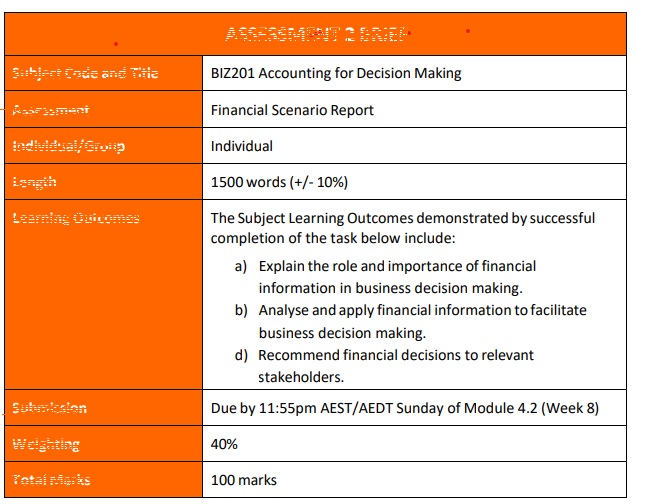Financial Scenario Report
Assessment Task
Calculate financial information for a given business case study. Then interpret and analyse
these results to demonstrate an understanding of how business decisions are made.
Context
Using Financial Statements of companies to perform calculations, interpreting results and
analysing them will help you develop understanding about how business decisions are made
in the industry considering the available financial information. By completing this
assessment, you will demonstrate the importance of financial information in business
decision making, including the application of financial statements analysis to business
decisions
Follow the instructions below to complete this assessment.
Download the provided workbook ‘Assessment 2 – Student Workbook.xlsx’ from the
Assessment 2 area on Blackboard.
2. Download the ‘Financial Statements Document’ from the Assessment 2 area on
Blackboard. You will use the information contained in this document for the
completion of tasks in this brief.
3. Complete the following calculations and tasks for the given business:
Conduct a horizontal (percentage) analysis of ‘Statement of Financial
Position as at 30 June 2023’ in the provided Excel Workbook within the ‘Balance
Sheet’ worksheet. Round your answers to two decimal places.
b. Conduct a ratio analysis of the years ended 2023 and 2022. Calculate the
listed ratios for Profitability, Efficiency, Liquidity and Solvency in the provided
Excel Workbook within the ‘Income Statement’ worksheet. Round your
answers to two decimal places.
c. Consolidate your findings and their impact on the decision making of the
business in the report by using the results of the ‘Ratio Analysis’ in the Excel
workbook to analyse company’s Profitability, Efficiency, Liquidity and
Solvency. Analysis should include answers to why a particular ratio is
changing, what factors (including numerical metrices) are causing this ratio
to the change. Recommend what must/can be done about this change
from the previous year. These recommendations should not be general,
they must be in particular (especially) for the company. They should be on
areas that need improvement or further investigation for the business and
must be thoroughly explained and justified. Your focus should be on the
given ratios in this part only. You must refer to the annual report for
analysis and give reference to the page number where you take the
information from.
d. With reference to the Statement of Cash Flows of the company in the
provided Excel Workbook, give reasons for the differences in the figure of
Net (Decrease)/ Increase in Cash and Cash Equivalents between 2023 and
2022 in the report.
*IMPORTANT: When completing calculations in the workbook, you are required to
show all workings through appropriate Excel formulas. Providing number results
without evidence of Excel formulas will not be accepted.
Report Format
It is essential that you clearly and effectively communicate your professional writing skills
through the report format and correct use of presentation and grammar. You must include
the following. You may want to include an Appendix; however, this is not compulsory.
Cover Page – It should include student name and ID, subject code and name, assessment
number, University’s name, learning facilitator’s name, submission date and word count. Be
creative while making your cover page!
Executive Summary – It should provide a succinct summary of the content within the report.
It should present information in such a way that readers are able to understand the intention
and key elements of the report without having to read the entire document. This section is
not an introduction to the company. This section is not included in the word count.
(Approximately 100 – 200 words)
Table of Contents – A summary of the sections (headings/sub-headings) and page numbers.
Introduction – The introduction should briefly introduce the company, not the report.
(Approximately 50 – 100 words)
Analysis & Recommendations – This section should include the analysis of your calculations
in part 3. b). Analysis should include answers to why a particular ratio is changing, what
factors (including numerical metrices) are causing this ratio to the change. Recommend what
must/can be done about this change from the previous year. These recommendations should
not be general, they must be in particular (especially) for the company. They should be on
areas that need improvement or further investigation for the business and must be
thoroughly explained and justified. Your focus should be on the given ratios in this part only.
(Approximately 1000 – 1100 words)
Profitability
Efficiency
Liquidity
Solvency
You may want to give recommendations under a separate section. If so, split the heading
‘Analysis & Recommendations’ into two.
Statement of Cashflows – This section should include reasons for the differences in the
figure of Net (Decrease)/ Increase in Cash and Cash Equivalents between the asked years in
part 3. d). (Approximately 400 – 500 words)
Conclusion – The conclusion should provide a concise summary of the report. No new
information should be included in the conclusion. (Approximately 50 – 100 words)
References – Torrens Academic Writing Guide – APA 7th for citing and referencing research
must be used. More information on referencing can be found at
https://library.torrens.edu.au/academicskills/apa/tool. Please see more information on
referencing in the Academic Skills webpage. There should be at least five reliable references
used in the report. At least 50% of the references that you use, must be from Torrens
University Library. You must provide the page number(s) for any annual report, textbooks,
journal articles and academic reference that you use in in-text reference. References are not
included in the word count

